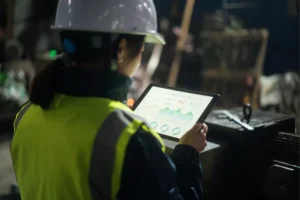Throughout my 40+ years in the petrochemical industry, I have had a front-row seat to watch the evolution of operational risk management (ORM). It’s been an exciting journey, from relying on my trusty clipboard at the start of my career to now having a tablet or smartphone which gives me access to risk information anytime or anywhere at the touch of a button or a swipe of a screen.
ORM is an integral part of safe and efficient daily operations across all hazardous industries. In the oil and gas industry, most injuries occur at the front line while work is being performed. Keeping people safe is the ultimate goal. However, I believe that we can only start to achieve this if we know the answer to the big question: What is the level of risk the worker and the facility are exposed to at any given time?
Let’s explore the stages we’ve gone through to get to where we are now in our quest to understand the real-time level of risk on our assets and facilities.
Stage One: A Step-by-Step Approach to JSAs
The term JSA has been around for a long time. In fact, it was first mentioned in 1964 by David D. Glenn in the fifth edition of the Accident Prevention Manual for Industrial Operations. Whether you refer to it as a job safety analysis (JSA), a job hazard analysis (JHA) or a task risk assessment (TRA), the process helps us get to a safe work solution. Through my experience working in the oil and gas industry in the Middle East, I’m personally more familiar with the National Safety Council’s JSA, which I’ll now explore further.
The process can be broken down as follows:
- Break the jobs into steps or tasks.
- Identify the potential hazards and/or injuries.
- Implement the necessary mitigation controls to nullify the hazards.
The first JSA I encountered was in 1990. I was asked to lead a team to develop a JSA to be used to uncover a buried 48-inch crude pipe. We were tasked with uncovering the pipe, cutting it and installing a valve. This particular job required a major excavation. The risk of being trapped by unstable soil (sand) was our main concern.
To put this into perspective, excavation fatalities are a serious problem in the construction and maintenance of oil and gas facilities. According to the U.S. Bureau of Labor Statistics (BLS), 166 workers died in trench collapses between 2011 and 2018. To put it bluntly, the stakes were high and we couldn’t afford any mistakes.
As a result of our JSA, we identified a requirement for specialized control measures to prevent cave-ins. This control method entailed bringing in a contractor to provide cement soil stabilization. We completed the job successfully, installing the flanged 48-inch motor-operated valve with no incidents or injuries. Due to the success of this operation, we went on to use the same JSA template as a basis for a total of 102 further excavations. These were all completed without incident, I’m happy to report.
Stage Two: Introducing the Concept of Risk
From our starting point of JSAs, we can move on to the concept of risk. This isn’t to say that we didn’t take risk into consideration before, but in stage two we move into a phase where risk becomes an integral part of the JSA process.
Whichever process you adhere to, whether that’s a JSA, TRA or JHA, the fundamental goal is the same: to reduce the likelihood of accidents at work and promote safety improvements in the oil and gas industry. Moving on from the simple step-by-step approach to JSAs in stage one, we now add the concept of risk into the mix. This means that we begin to assign a risk rating to each hazard identified in the job pack.
Using a risk assessment matrix, we can determine the initial risk qualitatively. When the initial risk ratings are determined, the JSA team must manually work through the list of unacceptable risks to specify the controls needed to reduce these risks to as low as reasonably practicable. This process has enabled us to move away from analyzing a hazard in isolation to clearly seeing the cumulative risk of interactions between multiple hazards.
JSAs started out on paper, filed away in folders on shelves, ready to be re-purposed for the next similar job. This process then moved to an electronic system, negating the need for dusty files, manual searches and the potential for lost documents.
With the introduction of technology, this process has become far more streamlined. We can now store hazards and controls for all types of work and develop risk assessment job-type templates to more efficiently plan work and manage risk.
This allowed us to spend our time focusing on the task as opposed to completing paperwork. In the case of an incident occurring while performing work under a JSA, we could quickly and efficiently determine:
- What happened and what went wrong.
- If the hazard was missed.
- If the control was not effectively performed.
- If a step in the job was missed.
Stage Three: Introducing the Concept of Risk Visibility
Stage three moves us on from simply identifying the risk to visualizing the risk. We now can visualize risk scenarios, which in turn help us make better operational decisions. Technology has taken us to a place where we can not only consider the impact of risk but visualize barrier-based process safety models and allow everyone from the boardroom to the front line to consistently see and manage operational risk across the enterprise. We can relate the collective performance of process safety systems to the real cumulative risk impact on operations at any given point in time.
This technological breakthrough had a tremendous effect on the organizations that have embraced it. By making risk visible to all employees, everyone can have a clear understanding of the risk present on the asset at any given time and in any location.
Now that we can achieve a clear picture of our operational reality based on risk, organizations in hazardous industries can change the safety-productivity dynamic and get more of the right work done. Throughout my work, I’ve seen organizations harness the power of this information and make better operational decisions that result in greater effectiveness, better efficiency rates and, most importantly, a safer working environment.
An example of this was a Middle East refinery turnaround where Sphera supplied nine SMEs (of which I was one) to develop JSAs for 40,843 separate but interrelated jobs and obtain client approval. The JSAs developed were repeatable for routine jobs for the turnaround, hence saving time and increasing efficiency for the operations team.
Stage Four: Mobility
Now it’s time to take a closer look at mobility and the exciting opportunities this new phase unlocks for us as an industry.
Workers on the front line are tasked with numerous assignments and tight deadlines. As a priority, they need to know the real-time risk of any potential hazard. As we discussed in stage three, visualization through technology was a huge gain. And now, risk assessments can be performed in the field and at the site of the job. The result of this is phenomenal. We can now experience faster, more accurate risk assessments and risk visualization at the job site.
Once the risk assessment is reviewed by the team back in the office and the mitigation controls are decided, the mobile device allows teams to confirm that the controls are in place. Then, the job can proceed.
More and more organizations are embracing this technological advancement. They clearly see that they can make better operational decisions. They can increase “tool time” and become far more efficient and safer as well. Work teams can now understand how their job impacts the overall picture of risk.
Field supervisors can receive notification of any potential hazard or risk on the plant. They know when to keep production flowing and when to perform critical maintenance. They can prioritize and manage the current and future work schedule based on risk. They can set alerts based on leading indicators of risk and notify executives and corporate managers that decisions need to be made to support their safety and operational performance targets.
And to think, ORM started with a clipboard!
Conclusion
We are now at an exciting point in the evolution of ORM, but where do we go from here? Organizations all around the world are harnessing the power of digital transformation as part of their ESG journeys. As ORM continues to evolve, I’m excited to see what comes next.





